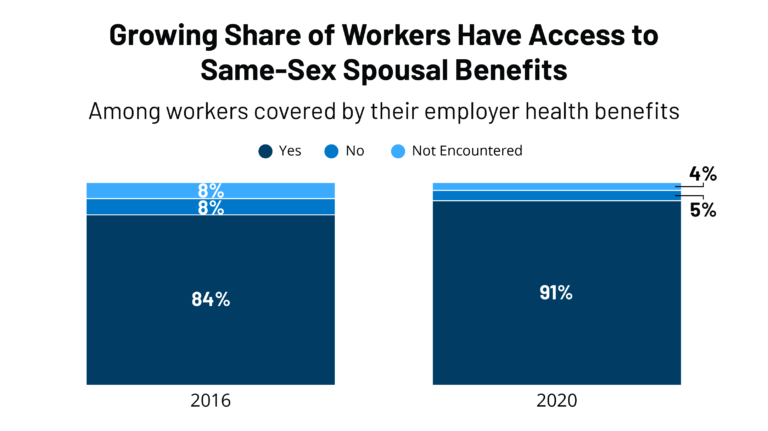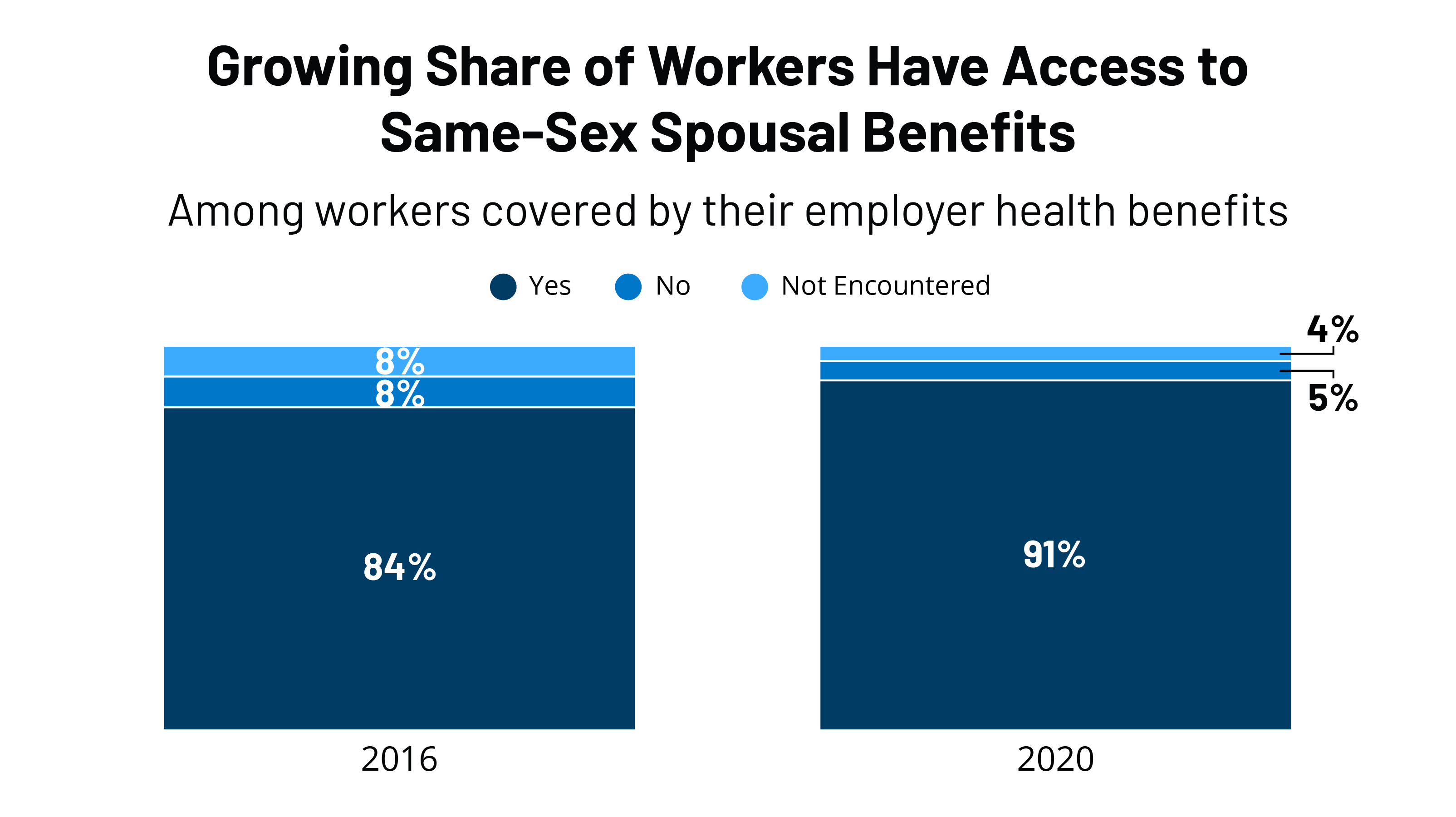

Background
The legal and policy landscape regarding protections based on sexual orientation and gender identity in health care and other areas has shifted markedly in the last decade. Most recently, on June 15, 2020 in Bostock vs. Clayton County, the Supreme Court of the United States ruled that, under Title VII of the Civil Rights Act of 1964, it is unlawful sex discrimination for an employer (with at least 15 employees) to fire an employee because of their sexual orientation or gender identity. It is likely that this ruling will have implications for employers’ decisions regarding health insurance coverage for employees with same-sex spouses, among other areas of employment.
Using the latest data from our annual Employer Health Benefits Survey (EHBS), we assessed access to employer sponsored health insurance (ESI) coverage for same-sex spouses during the first half of 2020 (prior to the Bostock decision), as well as trends over time; ESI remains the primary way people in the U.S. receive health coverage, either directly or as a spouse or other dependent., We find that, as of mid-2020, while employer offer of same-sex spousal coverage has increased over time, it remains less common than opposite sex spousal coverage. These increases follow two other Supreme Court rulings (United States v Windsor and Obergerfell v Hodges) which guaranteed the right to marriage nationwide and paved the way for wider access to health insurance through the workplace (see Appendix).
Findings
Firms Offering
In 2020, about three-quarters (74%) of firms offering health insurance coverage to opposite-sex spouses also provided coverage to same-sex spouses, a substantial increase from 43% in 2016 (see Figure 1). Of the remaining 26% of firms, 5% reported that they do not offer this benefit (similar to the share in 2018) and 21% reported they had not encountered this as a benefits issue, a finding driven by small employers (those with fewer than 200 workers), who represent the majority of employers overall (97%). It is becoming less common for employers to report not encountering this benefits issue.
The likelihood of employers offering both opposite-sex spousal coverage and same-sex spousal coverage increases with firm size (see Figure 2). Among firms offering opposite sex spousal coverage, large firms (those with 200 or more employees) were more likely to offer coverage to same-sex spouses compared to smaller firms (89% vs 73%). Almost nine in ten (89%) large firms with opposite-sex spousal coverage offered such coverage, 9% did not, and 2% reported they had not encountered this benefits issue. Among the largest firms (those with a 1,000 or more workers), 95% offered coverage to same-sex couples. By contrast, just 73% of small employers (3-49 workers) offered coverage to same-sex spouses. Four (4%) percent did not and 23% said they had not encountered it.
Covered Workers
While the majority of firms in the United States are small, the majority of covered workers are employed by large firms (200 or more workers) (see Figure 3). In 2020, among employees who worked at firms offering opposite-sex spousal health benefits, 91% also had access to same-sex spousal coverage, up somewhat from 88% in 2018 and 84% in 2016 and 2017 (see Figure 4). Five percent (5%) did not have access to this benefit, and 4% worked at firms who reported they had not encountered this benefits issue.
As with firms offering same-sex spousal coverage, the share of employees with access to this benefit increases with firm size (see Figure 5). Most covered workers (96%) at large firms (those with 200 or more employees) who have access to opposite-sex spousal coverage also have access to same-sex spousal coverage. Just 4% did not, and less than1% worked at firms that reported they had not encountered the issue. Among workers at the largest firms (1,000+ workers), nearly all (98%) had access to same-sex spousal coverage. Those least like to have access were employees at firms with 50-199 workers, 15% of whom did not have same-sex spousal coverage when opposite sex coverage was available.
Workers at small firms offering opposite-sex spousal coverage were less likely to have access to health insurance benefits for same-sex spouses, though a majority did (77%). Nine percent (10%) did not have access to this benefit and another 13% worked at firms that report they have not encountered this issue.
Conclusion
These findings indicate that access to employer coverage for same-sex spouses is increasing in the U.S., though it still is less than access to opposite sex spousal coverage. Coverage varies substantially by employer size, with employees at small firms having less access while those at the largest firms have almost uniform access to this benefit. In some cases, lack of access could be a policy decision, though that appears to be on the decline, with smaller shares of firms saying explicitly that they do not offer same-sex spousal coverage. Moreover, it is likely that the Bostock decision will have further implications for same-sex spousal coverage, with more firms being required to offer this benefit under the sex protections in Title VII. However, Title VII nondiscrimination protections do not apply to the 5% of employees at firms with less than 15 employee. Further, the Bostock court cautioned that employers could potentially secure religious liberty exemptions from extending sex protections to encompass sexual orientation and gender identity and it is yet to be seen how such exemptions interact with Title VII.
Methods
The annual survey was conducted between January and July of 2020 and included 1,765 randomly selected, non-federal public and private firms with three or more employees. In 2020, the response rate among firms which offer health benefits was 22%. The Bostock vs. Clayton County decision was released during the survey fielding period. Fifteen (15%) percent of the covered worker weight and 11% of the employer weight among offering firms was represented by respondents who completed the survey after June 15th. Some firms may have changed their coverage in the month following the Supreme Court decisions. Neither the percent of firms nor the percent of covered workers enrolled at firms who offer same-sex benefits is statistically different before and after June 15. For fuller methods see The Kaiser Family Foundation 2020 Annual Employer Health Benefits Survey available at: www.kff.org/ehbs.
This work was supported in part by the Elton John AIDS Foundation. We value our funders. KFF maintains full editorial control over all of its policy analysis, polling, and journalism activities.